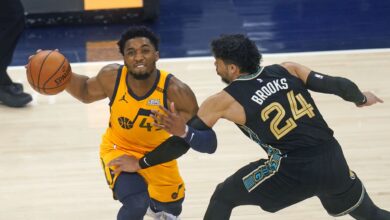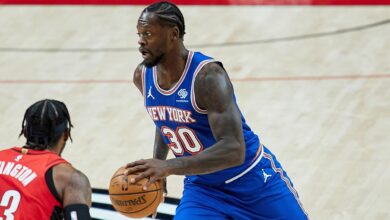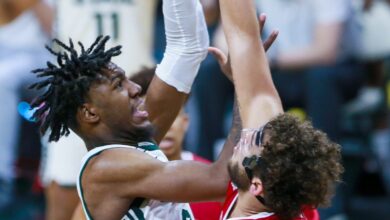The ‘unbelievable’ NCAA record of Buddy Schultz

Apr. 4—OXFORD — At that moment, Bud Middaugh was thinking only about a loss, not a legacy.
It was the ninth inning of a game against Wright State that was played exactly 50 years ago Saturday — April 3, 1971 — and the Miami baseball coach had tromped out to the mound to talk to his starting pitcher, junior left-hander Buddy Schultz.
The overmatched Raiders — who were playing the very first game in their program’s history — had managed to load the bases on a pair of walks and a single. There was just one out and Schultz recalls Middaugh not mincing words:
“He said, ‘I don’t care how many strike outs you have, we have to win this game. If another guy gets on, I’m taking you out!'”
Schultz said he thought to himself: “I’ve already struck out 24. We’re winning 6-0. Exactly what is the problem?’
He started to laugh: “I think he motivated me by really ticking me off.”
And that’s when Schultz -already considered one of college baseball’s best pitchers, his 1.06 ERA the season prior leading the nation — went back to doing what he did best his whole career and especially on this day.
He struck out the next WSU batter on a called third strike.
And he ended the game by retiring the final Raider with a swing-and-miss third strike.
Although the Miami victory has long been forgotten, Schultz’s extraordinary feat has not.
A half century later his 26 strikeouts remain an NCAA record for the most by a pitcher in a nine-inning game.
And, as it turns out, Middaugh embraced the effort, as well.
When the game ended, he saved the baseball Schultz had used and then inscribed it with the historic particulars:
Wright State
6-0
April 3, 1971
26 Ks
He presented the ball to Schultz at Miami’s season-ending banquet and Buddy kept it as he completed his Miami career the following year, spent five seasons in the big leagues with the Chicago Cubs and St. Louis and then embraced life after baseball.
After he married his wife Toby 20 years ago, the ball was kept on a shelf in the den of their Scottsdale, Ariz., home. Finally, at Toby’s prompting, he donated the ball to the Miami baseball program and today it’s on display — enclosed in a wood and glass case beneath a spotlight — in the Toby K. Schultz Heritage Hallway inside Miami’s Jay Hayden Baseball Center.
Although a 50th anniversary celebration had been planned for this weekend, the COVID pandemic — and the way it’s altered the RedHawks’ schedule — has forced the festivities to be moved to next year.
As he showed me the ball the other morning, Danny Hayden, Miami’s baseball coach, said with today’s pitchers often limited by pitch counts and other factors: “I can’t imagine that record ever getting broken.
“I think it’s going to be one of college baseball’s oldest, coolest and most unbelievable records for the rest of time.”
He said others are just as fascinated by the feat:
“I can’t think of a time when we had kids in this facility on a recruiting visit and we didn’t show them the ball. It’s part of everything we are. Every recruit and their parents, their eyes light up 100 percent of the time when they realize what that ball represents.
“They’re like, ‘Oh my God! That’s amazing!’ Not every program has an NCAA record and ours is a really cool one. And Buddy’s responsible for it.”
Every program doesn’t have an impressive baseball facility like Miami’s either.
“We have kids who come in here and they’ve already been on visits to some of the big Power 5 schools and seen their facilities,” Hayden said. “But they’re still wowed by what we have. I’d say we’re comparable to the top of the Big Ten Conference.”
And Buddy’s responsible for much of that, too.
“His 26 Ks are pretty cool, but that’s only a small part of what Buddy Schultz has done here,” Hayden said. “He’s raised money and donated himself. He’s done a ton for our program.”
As Schultz, who’s now 70, once told Vince Frieden, then the director of editorial services at Miami and now the school’s director of grant writings:
“Miami is a special place to me. It helped me grow up. I can’t pitch anymore, but this is how I can still help Miami win.”
Living out a childhood dream
Schultz grew up on Orinoco Avenue in East Cleveland.
“My mother was a homemaker and my dad, he had just a seventh grade education, but he served during World War II, worked three jobs and had great values,” he said.
At Shaw High School, he became one of the best pitchers in the state and with a herculean effort his senior year, he led the Cardinals to the Class AA state title. He pitched in seven of their eight tournament games and didn’t allow a run.
When rainouts condensed the Final Four to one-day doubleheaders, he pitched back to back shutouts, striking out 27 over the 14 innings.
“I got cramps in my forearm and wrist during the 14th inning and they came out and massaged it.,” he said.
He was able to finish the game, but that summer the Ohio High School Athletic Association passed innings limits on pitchers.
It’s called the Buddy Schultz Rule.
The Philadelphia Phillies drafted Schultz in the fourth round and offered him a $26,000 signing bonus, he said.
But Miami had been recruiting him for a couple of years — other schools had, too — and in the summers he had played with a semi-pro baseball team that featured three Miami players.
“I was still 17 and the Phillies wanted to send me to North Dakota, but I wasn’t ready for that,” he said. “I wanted to go someplace I was familiar with and I knew those Miami guys. I became the first person from my family to go to college.”
He said Miami was the perfect place for him.
There were the baseball feats — he was a two-time All Mid-American Conference first team selection and led Miami to a No. 14 national ranking in the final 1972 poll — and his classroom successes.
“I went to Miami on a baseball scholarship, not because I was smart,” he said. “I was a C-plus student at Shaw. But just as sports had taught me to find a way to win the game, I leaned to win in the classroom, too. Winning there meant graduating and I’m probably more proud of my diploma than my baseball because baseball came easy to me.”
The Chicago Cubs drafted him in 1972 and gave him a $6,000 signing bonus. He spent the last month of the 1975 season and 1976 in the Cubs’ bullpen and then was traded to the St. Louis Cardinals before the 1977 season.
Though he sent much of spring training pitching with the big league club, he was put on the Triple-A roster. Although the Cards soon brought him up when someone got hurt, he was quickly demoted back to New Orleans without playing when a trade brought Tom Underwood to the team.
Brought up suddenly again in June because of another injury, he immediately found himself starting against the Pittsburgh Pirates.
After giving up a run in the first inning, he retired 22 batters straight before being relieved by Al “The Mad Hungarian” Hrabosky in the eighth.
“Everybody loved the Mad Hungarian, but as I was walking off the field I heard all this cheering. It was more than Al usually got and that’s when I realized it was for me,” Schultz said. “Every person in Busch Stadium — like 32,000 — was standing and cheering for me. It wouldn’t have happened if I hadn’t first been sent back down like I had. They all knew what I’d gone through.
“I can’t tell you how special it felt.”
Before he could make another start, he pulled a leg muscle and once healed, he was put back in the bullpen. That season his 2.32 ERA was third lowest in the National League.
He played three seasons with the Cardinals and after baseball he found his niche as a fundraiser and became the executive director of the Harmon Killebrew Foundation annual golf invitational. He also became an ardent supporter of youth baseball, raising money for programs back in East Cleveland and throughout Arizona.
He wanted young kids to experience the life lessons and hopefully some of the opportunities — “Thanks to baseball I’ve been able to live out my childhood dreams” — the sport has given him.
Over 30 years he said he’s raised over $30 million for various groups.
Reconnecting with Miami
Schultz said he had no connection with Miami for almost 35 years after his graduation.
Then 13 years ago he had lunch in Mesa with one of his old Miami teammates who mentioned it was too bad he hadn’t graduated because he deserved to be in the Hall of Fame.
“I said, “I graduated, but not in ’72,'” Schultz said. “I explained that when I’d signed with the Cubs, I went to instructional league in Arizona. When it ended, I took my signing bonus and paid for my last semester at Miami. I graduated in 1973.”
The next day he got a call from the late Dave Young, then the Miami sports information director. That got the ball rolling and in 2010 Schultz was enshrined in the Miami Athletics Hall of Fame.
When I went back, I reconnected and remembered why I fell in love with the school in the first place,” he said. “Dan Simonds was the head coach then and I really liked him. And I love Danny Hayden now.”
He had maintained some connections with a couple of influential alums and he met new administrators and soon he saw a way he could make an impact.
“They were starting to build the Jay Hayden Center and I’d raised money for 25 years, so I offered my help.”
He headed the Legacy Program and other efforts and then, when a donor reneged on a $1 million offer to put artificial turf on the RedHawks’ field, he took up the project at the last minute and raised $1.3 million in 30 days.
He and Toby were one of those 13 prime donors and when officials wanted to name Heritage Hallway in the Hayden Center — which honors notable Miami big leaguers like Walter “Smokey” Alston, Charlie Leibrandt and Chris Sexton — after him, he instead asked that Toby’s name be put on it.
Danny Hayden said Buddy will be remembered for many other things:
“He’s been integral in all our upgrades we’ve done in recent years. A lot of it wouldn’t have happened at all — or at least not in the time frame it did — were it not for Buddy.
“He has a real passion for the young men in our program. I believe he feels he was really taken care of when he was at Miami and now he wants to pay it back.”
While Miami provided Schultz with so many things in his life, he knows the NCAA record has become his calling card:
“I played five years in the big leagues and I’m very proud of that. I played with and against a lot of great players. I’ve been on baseball cards and I’ve played the game in five countries around the world and all across our nation
“But I’m remembered for the 26 strikeouts That’ll be my legacy and I’m OK with that. I think it’s a good one to hang my hat on.”
During one of his trips back to Oxford, he said he was told: “The brick building that make up Miami’s campus are figured to last at least 100 years.”
And he knows the one thing that may outlast them is his “rest of time” record.
Source link






